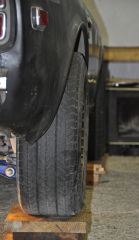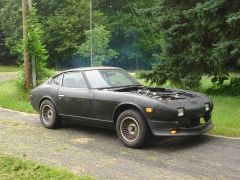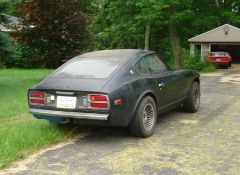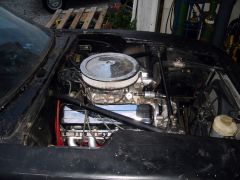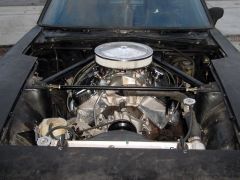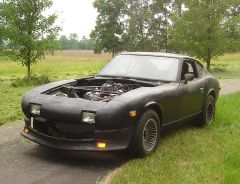-
Posts
825 -
Joined
-
Last visited
-
Days Won
7
Content Type
Profiles
Forums
Blogs
Events
Gallery
Downloads
Store
Everything posted by Michael
-
The Muncie M20 was a "wide ratio" (for the times!) 4-speed. First gear is around 2.56, and fourth is of course 1.0.... not the best choice for a Z. Unfortunately there has been little progress in V8-suited manual transmissions over the past 20 years. This is understandable, as the Gen-1 small block and Mark-IV big block have been obsolete for 20 years. Several aftermarket vendors modify the venerable T5, or its peers (Tremec etc.). At 350 hp, one supposes that a fairly conventional T5 would suit. Mine is an older build, with. Doug Nash 5-speed (not overdrive!), but then again, the engine is not 350 hp. If I were doing it all over again, I would probably go with a G-Force variant of a T5. As Miles noted, the JTR book remains useful as summary of the OEM options. There may be reason to improve on it, as it were, using a blow proof bellhousing and a hydraulic throwout bearing.
-

Front Suspension Swap? Anybody done one
Michael replied to rabrooks's topic in Brakes, Wheels, Suspension and Chassis
The inevitable question is whether the effort in doing something ambitious (research, sourcing components, fabrication, testing and adjusting) is justified by the eventual benefits. My personal feeling is that for those who have the skills and resources to do this successfully, the question no longer needs to be asked. For the rest of us, it's too easy to get seduced by impressive theoretical options, that end up only causing frustration and dejection. That said, my preference would be to start with some kind of suspension modeling software. The more sophisticated ones are doubtless expensive, but there should be a basic one available as freeware. A swap that used at one time to be popular, or at least occasionally encountered, was the front suspension from the C5 Corvette. -
The Mark-IV big block 454 is not to be confused with the LSX bored/stroked out to 454. The latter will fit anywhere that a Gen III-IV small-block will fit. The former is going to be challenging in a 300ZX. In the above post, the first photo is of a Mark-IV big block, while the second is the LSX. An fellow named Grumpyvette for some number of years posted expert advice on the care and feeding of the big-block 454, achieving both impressive performance-numbers and reliability. Doing this requires both an intuition for how parts go together, and as goes without saying, for acquiring said parts. Begin with the casting numbers on the heads and block. Are these a candidate for refurbishment, or ought one to ditch them, in favor of new (or at least alternative) parts? Writing today, in the summer of 2018, it is hard to justify a Mark-IV big block, unless one is particularly fond of them, has the parts and equipment to support them, and has a particular hankering for such a novel swap. I did this swap (with copious help) in an S30. That project included setting the firewall back 6". The big block will fit even without a firewall setback, and at least 2-3 people on this forum have built big-block S30s with stock firewall. Opinions on weight-distribution are of course their own matter. In a 300ZX, one supposes that the fit will be considerably less accommodating. If one is truly keen on doing this, one could aggressively cut metal and secure an eventual fit. Is it worth it? Again, very much a matter of opinion.
-

Kindred Philosophy - S30 Owners (+ generational Z family)
Michael replied to zredbaron's topic in Non Tech Board
This site began (now over 18 years ago!) as an antidote to “purism”. Purism is a zealous affection for one particular brand or model, to the exclusion of all others, where one regards said brand as being inviolable, and any introduction of alternative components is “impure”. In particular, in the late 1990s, the V8 swap was first becoming systematized, and this site was built as a home for persons interested in such a swap, without facing taunts and vitriol of detractors. Later, we realized that it’s all too easy to become clannish and insular about the V8 swap itself, and so, all sorts of variants came to be welcomed. Technology and tastes moved on. Today, perusal of sub-forums immediately shows that the most popular thing is the turbo, quite often on a straight-6, whether from the original S30, another Datsun/Nissan, or an entirely different brand. Mechanics aren’t known for being philosophers, but to the extent that there is a prevailing philosophy, I’d summarize it as being an easy-going minimalism and openness to alternatives. The easy-going part, means that there’s no stark loyalty to any brand, year, national-origin or technology. If it works, use it. The minimalism means that the best approach is the simplest. Why add complexity for complexity’s sake, let alone, for mere appearances? The openness combines the aforementioned two. If upon completing a swap, there comes to be a demonstrably better way of doing things, the old gets yanked, and the new attempted; unless of course one grows tired of too much tinkering, and has the maturity to accept things as they are. Some of the most venerable members on this Forum have died. Others have lost interest, faded away, or just gone silent. I miss them, and I miss those heady early days, when seemingly by the hour there were new, insightful, stimulating posts – the repository of knowledge growing. Forums themselves have changed. Now there’s you-tube and facebook… online guides and quicky updates. Who has time anymore, to craft lengthy and detailed essays? My own car has now been in various stages of incompletion and completion, for some 20 years. I’ve often lost motivation, and honestly, haven’t had much of it over the past couple of years. But this stasis and somnolence are not permanent. I look forward to renewed garage-sessions… and maybe even a recrudescence of spirited posting on this forum. -
Well, isn't it time now to be celebrating HybridZ's 18th birthday? It's now old enough to vote, to be drafted, to be criminally charged as an adult. It's not old enough to order its own parts, using its own credit card, with its own legally-valid signature. How will it function with its newfound maturity? On a more serious note - there must, there absolutely MUST be a HybridZ member somewhere out there, who wasn't yet born, when this site was started! Pray tell, who are you?
-

My new 280Z project -- advice, please
Michael replied to wingwalker's topic in Gen I & II Chevy V8 Tech Board
Rebuilding an automatic transmission is definitely a higher-end venture. Few of us here (even the seasoned veterans) would be in a position to offer actionable advice. Have you ascertained the condition of your engine? You found a local transmission shop, evidently building a good rapport with them. If you could do likewise with an engine shop, perhaps you could put the engine on a dynamometer, thus optimizing its tune? -

My new 280Z project -- advice, please
Michael replied to wingwalker's topic in Gen I & II Chevy V8 Tech Board
This is probably the L31 block, built between around 1995 and 2000, designed for a hydraulic roller cam. It's a Gen-II 350, so yes, you're in the correct forum. The casting to which you refer is not on the "bell housing", but on the portion of the block just head of the flat surface to which the bell housing would bolt... a minor quibble, but somebody already noted insistence of terminology, so one might as well continue. "Vortec" is GM's play-on-words, referring to cylinder heads that supposedly had better flow-numbers, and more efficient mixing in the combustion chamber. For stock heads, this is a reasonable combination. If you go about messing with the engine, in a quest for more power, that venture would require synchronizing changing of all sorts of components, as they work together. So, a larger cam might mean different valve-springs, or possibly even different pistons, depending on piston-to-valve clearance, combustion ratio and various other things. This is why most enthusiasts only change the exhaust manifolds (you already have "block hugger" headers, which are fine), the intake manifold and carb. The engine's mating to a TH350 is certainly possible, but I would have suspected a 700R4, or similar variant. Ultimately, do you want an automatic, or a manual? A non-overdrive transmission is not necessarily such a horrendous evil, especially if you install a 3.54 rear-end. Looking at the second photo that you posted, the distributor housing is only about 1" from the firewall, and the stock hood-latch receiver panel appears to have been removed. These are telltale signs that the engine is already in the "JTR" position, or close to it, even if the engine-mounts were custom-made according to some other rubric. So, I'd leave that alone. The absence of a transmission talehousing mount would be outright ridiculous - but not inconceivable. One can be fabricated according to the ubiquitous JTR method. The JTR web-site used to sell (do they anymore?) their parts, and if not, there are patterns floating around the internet. By my reckoning, the first step would be a tune-up... get the engine running, set the timing and so forth. Upgrades can come later (possibly much later). Overall, this looks like a clean car, and a successful buy. Congratulations! -
Not to be the acerbic dissenter here, but sometimes it is more satisfying (not to mention, more illuminating) to get components that are of marginal robustness, but which are standard, common and well-researched... try them out, see if they happen to work, and then replace if/when failure happens. Too often, we overbuild; we overspend, end up for example with a clutch that's too heavy to be comfortable, with a "bulletproof" transmission with heavy/cumbersome gear-engagement, and so forth. I personally made this mistake, in going with a Doug Nash 4+1 transmission... "bulletproof" indeed, but a chore to shift, with gears that are too closely spaced. At least the clutch was a success... Centerforce dual-friction; Hayes 168-tooth aluminum flywheel - both from the Summit catalog. The one semi-unorthodox piece was the McLeod hydraulic throwout bearing, obviating a clutch-fork or pivot point. In sum, consider the typical small-block build from the Summit or Jegs catalog. It should work fine.
-
"Drifting from side to side" at highway speeds is often imputed to bad aerodynamics. In my view, this is partially correct. If the consumables in the suspension are worn, but only slightly worn, then with sedate driving on surface-streets, there may be no sensation of there being anything amiss. But at highway speeds, the steering might grow light, or otherwise twitchy. In steady straight-line driving on smooth pavement, there are presumably no strong transient forces - or than those having to do with wind. So, it's not the case that the aerodynamics are inherently bad (and least, not entirely), but rather, than wind-effects at higher speeds expose problems with the (front) suspension, that would not otherwise have been noticed. That at least was my own experience, driving a worn but serviceable 240z on the highway, now so many years ago.
-

am I gonna regret swapping for a more modern sports car?
Michael replied to thedarkie's topic in Non Tech Board
Here's adding my voice to the chorus advocating for having BOTH cars: the S30Z, and a much newer model for general driving-duty. With an older car, attaining a high level of performance almost invariably means sacrificing comfort, utility and the general niceties of care-free hopping into the vehicle, and just taking off. This, I think, is a worthwhile trade, for building something truly personalized and invigorating to drive. But especially as we get older, and come to rely on transportation for stodgy and utilitarian duties, the various compromises become less and less tenable. We're forced to relent and to avail ourselves of something newer. But why should that mean dispensing with the pride of decades' tinkering and achievement? -
Yes. I'm too lazy/inept to include definitive links here, but I have a 454 with a few bits to improve it, a Doug Nash 5-speed and some chassis mods to accommodate the setup. Several others have big block Chevy engines with stock firewall/frame rails. About 15 years ago we had on this Forum a couple of really impressive bbc Datsun drag cars... full tube chassis, back-halved. With the ubiquity of the Gen-IV small block, the old-school big block has understandably become a rarity.
-
There's a plethora of reviews online for Gen-1 SBC aftermarket heads; see Hot Rod and similar magazines, who regularly publish comparison-articles. A specific recommendation is not possible, because (1) aftermarket offerings change rapidly, and (2) it depends very much on one' particular application (displacement, desired rpm band, compression ratio and so forth). If completely lost, call Summit or Jegs, and they'll offer some verbal advice.
-
The years roll on, and despite an ever-increasing proliferation of brake options, there remains tense debate on whether "stock is best, if well-maintained", or whether now in 2016 an upgrade is sensible. Like many of us, I've had a car sleeping for decades. If it awakes, it will need thorough overhaul of brakes - and if that's stock, it will be some form of rebuilt components. Towards that end, I keep wondering: is there an incrementally lighter and more aggressive variant on the stock 280Z front brakes? Does anyone make the stock casting of the brake-caliper, but in aluminum? Or perhaps another caliper that works with the stock rotors, without an adapter-bracket, but which offers more piston-capacity, and/or less weight? I say this because on the one hand, I'm leery of an ambitious brake-upgrade venture. But on the other hand, it seems to be timid and unimaginative to merely be replacing 40-year-old components with identical (but rebuilt) parts.
-

Rota TBT's.... anyone running them?
Michael replied to The Infidel's topic in Brakes, Wheels, Suspension and Chassis
Aesthetics aside, the appeal is that a 4-lug pattern is propagated into the webbing of the wheel. I'm not a structural engineer, but intuition suggests that such usage of a 4-pattern makes possible a lighter/stronger wheel, than if the lug-pattern were ignored (meaning, for example, a 5-spoke wheel in 4-lug pattern). Unfortunately this wheel does not appear on Rota's web site, http://www.rotawheels.com/wheels.php . A simpleminded Google search reveals an offering from Amazon, in 15x8, but unfortunately in the Miata lug spacing, 4x100mm: https://www.amazon.com/NEW-ROTA-TBT-15X8-PCD/dp/B01DB7M8R6 . Has anyone seen this wheel in 4x114.3? Or any specs on weight? -

Wheel clearance ??x9.5 +0 ?
Michael replied to Ereschkigal's topic in Brakes, Wheels, Suspension and Chassis
Apologies in advance if I'm making an obtuse or condemnatory point, but what is the advantage of mounting 245-series tires on 9.5" wheels? Would it not be more sensible to use narrower wheels for 245 tires, or perhaps to attempt wider tires for 9.5" wheels? Tirerack.com recommends 8"-9.5" wheels for 245/40-17, with something like 8.5" as standard. That being the case, if the objective is 245/40-17 wheels, might there not be an advantage in fitment (and lower rotating mass) in going with a narrower wheel? -

240Z Chassis prep / reinforcements
Michael replied to Kurai's topic in Brakes, Wheels, Suspension and Chassis
Time passes. The OP evidently sold his Z last year. The person to whom is ascribed above the mention of irritation, has recently passed away. -

Coilover Leveling Issues
Michael replied to ~KnuckleDuster~'s topic in Brakes, Wheels, Suspension and Chassis
The car was resting on three points: the bottom of the differential housing, a point on the driver's side of the front cross-member, and a point on the passenger's side of the cross-member... correct? Was the floor level? Were the two front jackstands at equal height? If the answer is "yes" to both, then that's evidence (but not proof) that the unibody is in OK shape. First, I wanted to publicly compliment you on the aesthetic beauty of your suspension components - even if they're not level or not yet fully functional. Many of us armchair-critics can't sport something so elegant. Second, it may be the case that the McPherson struts themselves are uneven. On my car, the front axles (correct term?) were improperly aligned with respect to the strut housings... an OEM defect. The late John Coffey pointed out that this problem is fairly widespread. It took several junkyard outings to find a matching pair of front strut assemblies. Well, this may or may not be a culprit in the car-leveling issue, but it is suggestive that some other source of unevenness could reasonably be traced to the strut assemblies. -

Coilover Leveling Issues
Michael replied to ~KnuckleDuster~'s topic in Brakes, Wheels, Suspension and Chassis
It is indeed. This site has become an austere and staid repository, rather than a discussion-group. But that's an issue beyond the scope of the present thread. Resuming the topic, perhaps it might be worthwhile to remove the McPherson struts from all four corners, stack them up alongside each other, and compare. There may be some obscure anomaly that mere under-car inspection can't detect. It may for example be possible that the rubber isolators atop of each strut-housing are broken, or mismatched, or that something else is mockingly dangling. There might have been mixing between 240Z and 280Z components. -

Wheel Show! Post your pics of you wheels
Michael replied to k3werra's topic in Brakes, Wheels, Suspension and Chassis
Nice wheels. Have these been successfully fitted to a S30? Z31-type front hubs/rotors? What about the rear? Wheel weight? -

The search is on for new rims!
Michael replied to rickyellow zee's topic in Brakes, Wheels, Suspension and Chassis
Mtnickel, what is your car's ride height, as measured for example from the center of the door key-hole, to the floor? I'm asking because I've cut off 1.5 coils from the (stock) springs, and yet, my car appears to be about 1" higher. -

327 v8 240z. Swap or build?
Michael replied to nicholas1122459's topic in Gen I & II Chevy V8 Tech Board
The culture has changed. 20 years ago, when some of us were starting these swaps, the small-block (Chevy or Ford) was all that there was. Fuel injection was a newfangled thing, that domestic OEMs had just recently figured out and made reliable, while the aftermarket was just starting to offer kludged "kits". New it's LS-this and Coyote-that, with the classical blocks regarded as we once regarded Flatheads. Still, when I go to my local car-show, the hotrods almost invariably have the classical engines. The people building them are almost invariably more familiar with the classical engines. If this is the community on which we draw, for advice, for parts, for camaraderie, then there's excellent reason to retain the classical engine, and to improve it. -

The search is on for new rims!
Michael replied to rickyellow zee's topic in Brakes, Wheels, Suspension and Chassis
Much depends on ride-height. In going through the sort of exercise that prompted this thread, I placed my car on wooden blocks underneath each tire, keeping normal weight on the tires, and elevation of each corner even, but leaving space to crawl underneath the car to take pictures. http://forums.hybridz.org/gallery/image/33780-rear-right-tire/ shows space between the rear strut-tower's spring-perch, and the tire lip. This is with 14"x7" "Western Cyclone" wheels, and 225-60/14 tires. The backspacing of these wheels is ~ 3 3/4" (sorry if I'm off by a fraction - memory is spotty). There was about 1 1/2" of gap... perhaps 1 1/4". The upshot is that 1" of backspacing can be accommodated at this ride height, with plenty of space remaining. This concerns the inboard side. On the outboard side (see http://forums.hybridz.org/gallery/image/33781-rear-right-tire-outboard/), if we go with an 8" wheel and something like a 245-series tire, quite likely the tire will protrude beyond the fender-lip. However, at this ride height, I don't see that as being a problem. At other ride heights, or other camber settings, there may be a problem. This is why these things are so situational and so difficult to definitively recommend. Based on available tire choices, I find myself leaning - as many others have already decided - towards 17" diameter wheels. There are excellent tire-options for 17"x8" rims. -
From the album: Big Block Z - Summer 2006
-
From the album: Big Block Z - Summer 2006

